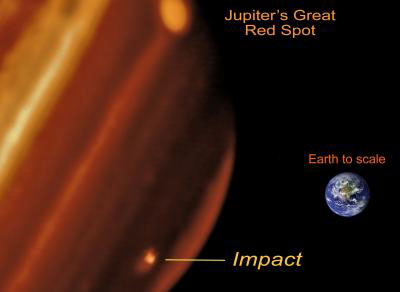Jupiter's New Bruise Big As Pacific Ocean

The darkbruise that appeared suddenly near the south pole of Jupiter several days ago,likely as the result of an impact by a comet or asteroid, is as big as the Pacific Ocean, astronomers report.
The darkspot was firstnoticed by chance by amateur astronomer Anthony Wesley in Australia on Sunday, July 19.
The blemishis thought to be the result of an impact similar to that of CometShoemaker-Levy 9, which pummeled the gas giant 15 years ago.
After hewas convinced the spot was not just another storm or the shadow of one ofJupiter's moons, Wesley alerted other astronomers around the world to the scar'sappearance.
University of California, Berkeley, astronomerPaul Kalas took advantage of previously scheduled observing time on the Keck IItelescope in Hawaii to image the blemish in the early morning hours of Monday,July 20. The near-infrared image showed a bright spot in the clouds ofJupiter's southern hemisphere, where the impact had propelled reflectiveparticles high into the relatively clear stratosphere.
In visiblelight, the bruise appears dark against the bright surface of Jupiter.
Theseobservations mark only the second time that astronomers have been able to see theresults of an impact on the planet, the first being Comet Shoemaker-Levy 9'scollision. Many theories were formed after that collision.
Get the Space.com Newsletter
Breaking space news, the latest updates on rocket launches, skywatching events and more!
"Nowwe have a chance to test these ideas on a brand new impact event," Kalas, said.
Kalas andhis colleagues hope their observations will shed light on the nature of the impact.
"Theanalysis of the shape and brightness of the feature will help in determiningthe energy and the origin of the impactor," said Marchis. "We don'tsee other bright features along the same latitude, so this was most likely theresult of a single asteroid, not a chain of fragments like for SL9 [CometShoemaker-Levy 9]."
Mike Wong,a UC Berkeley researcher currently on leave at the Space Telescope ScienceInstitute in Baltimore, used the observations to calculate that the bruise isnear the southern pole of Jupiter (305 degrees west longitude and 57 degreessouth latitude in planetographic coordinates) and that the impact covers a190-million-square-kilometer area, as big as the Pacific Ocean.
Because ofthe complex shape of the explosion, it is possible that tidal effects (thegravitational tugs of Jupiter and its moons) fragmented the impactor ? a cometor asteroid ? shortly before it collided with the planet.
Later thisweek, astronomers from UC Berkeley and around the world plan to conducthigh-resolution visible and ultraviolet observations of the impact site usingthe Hubble Space Telescope's brand new Wide Field Camera 3. Ground-basedfacilities including the W. M. Keck telescope will also use adaptive optics toobtain much sharper infrared images of the impact's aftermath.
- Video - The Jupiter Crash of Shoemaker-Levy 9
- Jupiter Apparently Smacked by Rogue Object, New Images Reveal
- Images: Jupiter and Its Moons
Join our Space Forums to keep talking space on the latest missions, night sky and more! And if you have a news tip, correction or comment, let us know at: community@space.com.

Space.com is the premier source of space exploration, innovation and astronomy news, chronicling (and celebrating) humanity's ongoing expansion across the final frontier. Originally founded in 1999, Space.com is, and always has been, the passion of writers and editors who are space fans and also trained journalists. Our current news team consists of Editor-in-Chief Tariq Malik; Editor Hanneke Weitering, Senior Space Writer Mike Wall; Senior Writer Meghan Bartels; Senior Writer Chelsea Gohd, Senior Writer Tereza Pultarova and Staff Writer Alexander Cox, focusing on e-commerce. Senior Producer Steve Spaleta oversees our space videos, with Diana Whitcroft as our Social Media Editor.









